Bouba
Well-known member
While the Honda’s are great engines...Cummins is pretty special as wellI think I would take Cummins non run in statement as marketing and not a sign of better manufacturing practices than the Japanese.
While the Honda’s are great engines...Cummins is pretty special as wellI think I would take Cummins non run in statement as marketing and not a sign of better manufacturing practices than the Japanese.
I think it's as others have said above. Run in periods are becoming extinct. The theory was that running in lets imperfect surfaces grind together so that they fit, especially piston rings, but in modern production machined surfaces are made perfectly to begin with. Also, manufacturers now ship engines with "running in oil".Question: (out of interest)
- Do the MTU engines have a run-in period, or did they do that in the factory ?
- Can you use the boat at full throttle ? did SL do sea trials at max speed ?
- does SL need todo some fine tuning on the prop-pitch ? or do they have enough experience with this model, to set this right from the beginning ?
with your spec, the weight must be on the "upper scale" of the 96A's ?
AgreeWhile the Honda’s are great engines...Cummins is pretty special as well
Perhaps it’s just as JFM says in his last post...it’s to do with the high RPM of the Honda outboard compared to a low revving dieselAgree
My interest is more in why there are two different approaches to running in from two great manufacturers
Really?with a Tesla you need to run in the motors..but you can run in the batteries
Slight miss type I am sorry…it should read that you ‘don’t’ need to run in the motors…I will collect the battery info and PM it to you…apologies to JFM and for the mistypeReally?
I'm half thinking to get a model 3, tell me more about it.
With apologies to jfm for the small drift...
My MTU factory visit was 14 years ago but I do remember a huge testing facility.I think it's as others have said above. Run in periods are becoming extinct. The theory was that running in lets imperfect surfaces grind together so that they fit, especially piston rings, but in modern production machined surfaces are made perfectly to begin with. Also, manufacturers now ship engines with "running in oil".
I did the seatrials on both my Cat C32 boats and for sure they were run at WOT with only 2-3 hours on the clock, with Cat engineers on board. I think it will be the same with MTU but I have not seen their documentation yet. On the Yamaha outboard we took delivery of last year, there were running in instructions saying (basically) no WOT until 2 hours, and no continuous WOT until 10 hours, but of course that's a 5000rpm engine unlike a big diesel at ~2200rpm. I don't recall getting any running in instructions with any new cars in the last few years but I usually don't read the documents because I don't care about cars.
I don't know if Sanlorenzo will need to fine-tune the prop pitch. Maybe they can judge/calculate and get it correct first time. My boat is a bit heavier than standard but with a base spec of 100 tonnes it's hard for a customer to make any difference. I would guess that my boat is about 2 tonnes heavier than a typical boat in the SL96A series, mainly due to a lot of extra marble in the bathrooms (800-1000kg) plus extra pumps and winches, and bigger hydraulics (=1000kg extra). Much more importantly I have specced the MTU 16v2000M96 engines, not the usual M92 series (=2434 hp instead of 2216hp), and therefore I expect coarser props than standard.
You are, of course, correct about car ICE’s. When I was a student at Jaguar in the late 70’s, all engines, V12 and I6 were hot tested for at least 30 mins, and the cars were subject to a running in period. Not just for the engine, but also other systems like brakes.I think it's as others have said above. Run in periods are becoming extinct. The theory was that running in lets imperfect surfaces grind together so that they fit, especially piston rings, but in modern production machined surfaces are made perfectly to begin with. Also, manufacturers now ship engines with "running in oil".
I did the seatrials on both my Cat C32 boats and for sure they were run at WOT with only 2-3 hours on the clock, with Cat engineers on board. I think it will be the same with MTU but I have not seen their documentation yet. On the Yamaha outboard we took delivery of last year, there were running in instructions saying (basically) no WOT until 2 hours, and no continuous WOT until 10 hours, but of course that's a 5000rpm engine unlike a big diesel at ~2200rpm. I don't recall getting any running in instructions with any new cars in the last few years but I usually don't read the documents because I don't care about cars.
I don't know if Sanlorenzo will need to fine-tune the prop pitch. Maybe they can judge/calculate and get it correct first time. My boat is a bit heavier than standard but with a base spec of 100 tonnes it's hard for a customer to make any difference. I would guess that my boat is about 2 tonnes heavier than a typical boat in the SL96A series, mainly due to a lot of extra marble in the bathrooms (800-1000kg) plus extra pumps and winches, and bigger hydraulics (=1000kg extra). Much more importantly I have specced the MTU 16v2000M96 engines, not the usual M92 series (=2434 hp instead of 2216hp), and therefore I expect coarser props than standard.
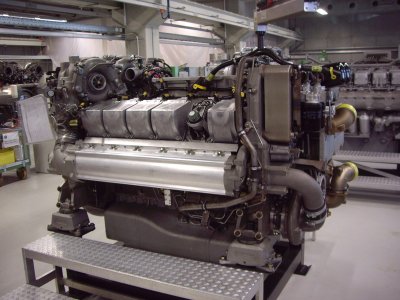
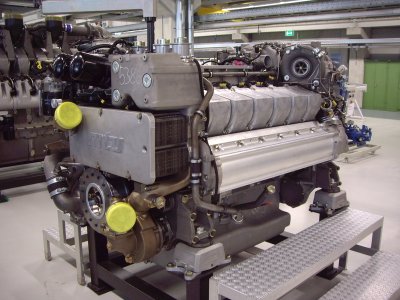
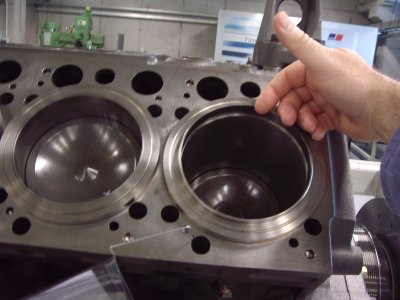
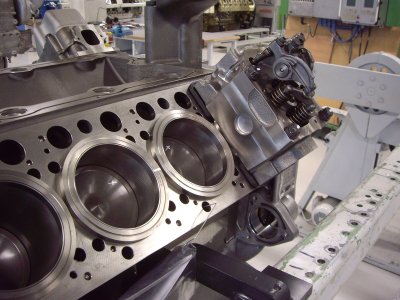
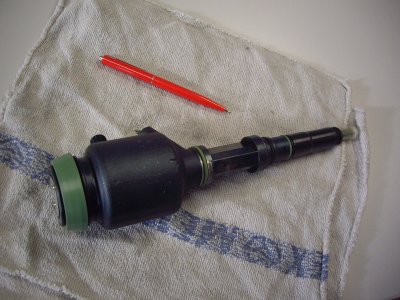
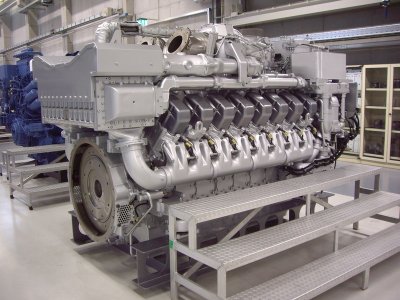
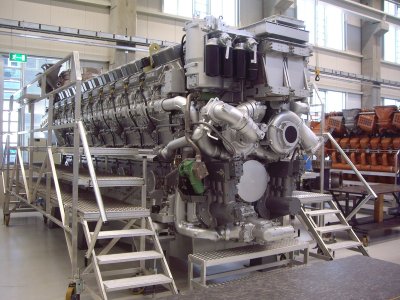
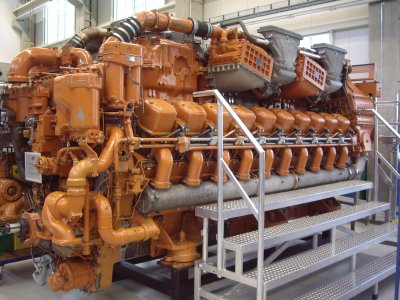
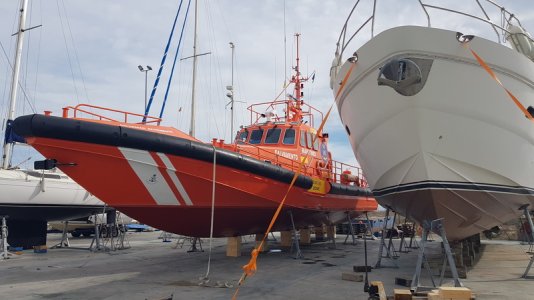
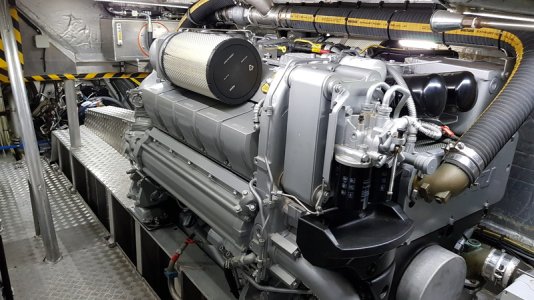
That was super interesting! Thanks for sharing. i assume they have a “head gasket” per head? Must be an interesting shape looking at the height and lack of gap between cylinders?For those interested, at the time of my visit (things might have changed a bit) and how I remember it.
Remember that I'm not an expert - just an enthusiastic MTU owner.
The MTU engine range that we know in the marine world is called the CR2000.
CR stands for Common Rail and the 2000 is the nominal size of each cylinder - 2 litres - actually, it is 2.2 litres.
(Each cylinder has the cubic capacity of most family cars).
The xxV at the front denotes how many cylinders and that they are V engines.
Mine are CR2000 8V so that means I have V8s.
This makes JFM's 16 cylinder in Vs at 35 litres each engine!!
AFAIK, the M number is the version number.
Mine are M93s - JFM says his are M96 so several generations later.
Here are some photos of the CR2000 engine from the MTU workshop in Friedrichshafen (Germany).
Sometimes it is nice to see the engines without any paint.
View attachment 172651
View attachment 172652
This shows the size of each cylinder
View attachment 172653
All the cylinder heads are modular so can be removed individually.
View attachment 172654
Just to appreciate the scale, this is one of the injectors (I'm glad I have only got 16 of them - they must cost a fortune to replace)
View attachment 172656
The CR2000 engine is one of the smallest that MTU make.
They also have a CR4000 and 8000 ranges (4 litres per cylinder and 8 litres per cylinder respectively)
Here are some photos of the bigger ones
View attachment 172657
View attachment 172658
View attachment 172659
Whilst I' on the subject of MTUs and specifically the CR2000, I always take an interest whenever I see them about.
For example MTUs were fitted to this Spanish Lifeboat (Salvamento) - in the yard next to my boat.
View attachment 172660
I got to know the crew so they arranged a tour for friends and I - this is the engine room - CR2000 V10
View attachment 172661
I just thought you might find it interesting - and put some pics to the model numbers that have been quoted.
looks like they use an "O" ring on the top of the cylinder sleave.That was super interesting! Thanks for sharing. i assume they have a “head gasket” per head? Must be an interesting shape looking at the height and lack of gap between cylinders?
That’s amazing precision to seal on the cylinder sleeve and the block surface. No room for error there.looks like they use an "O" ring on the top of the cylinder sleave.
@Hurricane did a big write up on his trip to the MTU factory a good few years ago it was a very interesting read
Interesting - as you say, they must have changed things - just checked my invoice and the full description is MTU 8V2000 M93 (1200hp) - then gives the serial numbers.These days they don't use "CR" in the engine name. Yours are called 8V2000 M72 or M74 these days, and mine are called 16V2000 M96. On the 16V version, the M93 and M96 denote tier 2 and tier 3 versions of the 2434hp version respectively, but that isn't true of other models. Eg 8V2000 M72 and M74 are both tier 2, 16V2000M86 is 2216 hp tier 3; 16V2000M96 is 2400 hp tier 3 (mine); and 16V2000M96L is the 2600hp tier 3 version. Also, as those 3 names show, some but not all models have an extra letter on the end (in this 16V case, the L).
Was watching a video of a guy in the US that had bought a Scania 144 V8, it's engine is pretty much like the above MTU in design, though a lot less power at 460hp, sleeved cylinders with separate heads, he had to strip the engine down and the sleeves are O ringed top and bottom to the block and head. Which means that you can take out one cylinder and repair it without having to disturb the rest of the engine.That’s amazing precision to seal on the cylinder sleeve and the block surface. No room for error there.
I edit
Looking again there is some thick material under the cylinder head which I guess takes up any errors or tolerance build up, so you can pull well down to create a good seal on the sleeve while letting the ‘thick material“ look after the block seal.
Interesting that it’s push rod but I suppose with a slow revving engine valve bounce doesn’t figure.
And the piston?Which means that you can take out one cylinder and repair it without having to disturb the rest of the engine.
Hmmmm!And the piston?
Possible the design allows the lead to ride over the rings, however I would be very surprised if the reason for sleeve replacement didn't affect the requirement for a new piston or at least rings.Hmmmm!
I wonder if you can get a replace sleeve over the piston.
And the piston?
Still has to be replaced through the bottom of the crankcase, and you have to take the sump off to replace the piston and or the sleeve, Ill have a look for the video - but it is typical American fare, the guy goes under the name of Bruce Wilson on youtubePossible the design allows the lead to ride over the rings, however I would be very surprised if the reason for sleeve replacement didn't affect the requirement for a new piston or at least rings.